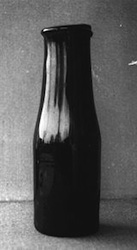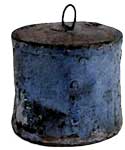Canned Food

Nicholas Appert
In 1824 a four-pound tin of roast veal made the long voyage to the Arctic Circle and back. It was part of the stores taken by Sir William Edward Parry on his expedition to search for a north-west passage through the ice around the top of America. The veal wasn’t needed, so two years later the same tin went on Parry’s next voyage of discovery. Still it wasn’t eaten. ‘Roasted Veal, cut round on the top near to the outer edge with a chisel and hammer’, read the instructions on the side of the container. Somehow it got stored at a military museum. Here it stayed until 1938, when excited scientists prepared to open the oldest known tin of preserved meat. What would the veal cooked a hundred and fourteen years ago be like? The tin had survived all its travels without denting or perforating. And the big pieces of pink veal inside were in perfect condition. They looked as if they had been recently cooked. Laboratory mice and a cat fed portions of Admiral Parry’s roast veal enjoyed every bit.
In 1824 the canning of foods was a new process. A Frenchman, Nicolas Appert, worked out the methods in the small kitchen behind his shop in a village near Paris. Appert had trained as a chef, brewer and confectioner, all useful qualifications in his search for a new way of preserving foods. He began experimenting in 1795. France was in a turmoil of revolution and war. The Emperor Napoleon led his armies through Europe – and marching armies needed food above all. Napoleon offered a prize of twelve thousand francs to the inventor of a new process for preserving food.

An Appert Canning Jar
Like everyone else, Appert thought that contact with the air, probably the oxygen in it, caused food to decay and spoil. So he packed food into glass containers, specially designed with wide tops. The bottles were loosely corked, heated in a water bath while air was driven off, then tightly corked so no more air could enter, and boiled again. This method is in fact almost the same as people use today to preserve fruit and vegetables at home. By 1804 he had carried out hundreds of experiments to discover how much heating for how long was best for which kinds of meat, vegetables, fruit, even milk. Often he had to wait months, watching to see if the bottled food would after all go bad. In 1810 Appert published his book ‘The Art of Preserving All Kinds of Animal and Vegetable Substances for Several Years’. He described how to preserve the simplest foods, as well as the most elaborate, such as: “A matelot of eels, carp and pike, with veal sweetbreads, mushrooms and anchovy butter, the whole cooked in white wine”. Appert won Napoleon’s prize and invested all the money in more experiments and a food-processing factory. He died poor, but his descendants ran a successful business for many years.
In England, Peter Durand read the translation of Nicolas Appert’s book. He decided that tin plate would make a much better container for preserved goods than glass. It was stronger, lighter, conducted heat better, could be formed into any shape, and completely sealed. Tin plate – rolled iron with a minute layer of tin – had been made in Britain since the early eighteenth century, using tin mined in Cornwall The owners of an iron works in London, John Hall and Bryan Donkin, saw the opportunity for business. They experimented with the temperatures and times needed to preserve foods in the new tinned canisters, and by 1812 were able to offer their revolutionary product to the British Admiralty. Ships’ rations had been salt meat and hard biscuit for hundreds of years. The naval authorities knew that sailors died of the dreaded scurvy because they lacked fresh vegetables and fruit. Here was the chance to change shipboard diet. Tinned vegetable soups, carrots, meat: all were tried on long sea voyages, at lonely outposts and on expeditions like Parry’s. They proved successful. Donkin and Hall had a special method of checking their products. After cooking, stacks of containers were put in a test chamber, with temperatures around 100 Fahrenheit for a month. If the food were eventually to go bad, it did so now: the ends of the tins bulged with gases and sometimes exploded. If they survived this treatment they would survive anything, boasted the manufacturers. ‘Meat thus preserved eats nothing, nor drinks – it is not apt to die – does not tumble overboard,’ wrote a delighted naval officer. ‘It is always ready, may be eaten hot or cold …’

Several Englishmen took the newly-invented method of preserving food to America in 1817. William Underwood carried out his preserving of fruit and pickles in New York, but carefully labelled the bottles ‘Canned in Britain’ so that they would sell better. Tin cans were not used in America until 1840. The American Civil War increased production tremendously: food for the troops again. All Gail Borden’s newly-invented condensed milk in cans was commandeered by the Northern army. About a hundred years ago the enormous meat-packing industries using canning techniques were started in Chicago. Australia was ahead of the United States in the canning business. Two wealthy grazier brothers opened the first factory in New South Wales in 1847; and soon canned mutton was being exported to England.
About the middle of last century, scandals broke out in England. The meat in tins was bad! Thousands of containers were condemned as unfit for human consumption. One big English firm had a factory in Rumania; the angry British public accused this firm of putting old, unhealthy animals into tins. The trouble was that no one really understood the processes of food preservation. Why did Appert’s methods of heating and air removal usually work? In the 1850s, research by the French chemist Louis Pasteur revealed the part microbes play in the decomposition of food (see article on pasteurisation). He showed the importance of heat in killing the polluting microbes, and the need to keep food from all contact with the air immediately after heating. But Pasteur’s researches were not used in the canning industry for another forty years. Canners worked by trial and error, and losses from spoiling were often heavy.
Part of the trouble was that manufacturers around 1850 began to save time and space by preserving food in much bigger containers. An old man interviewed when the roasted veal tin was opened in 1938 said he had once talked to an Admiralty inspector who checked bad tins in 1850. The meat in the centre of each tin, according to the inspector, was quite uncooked: the cans were too big for heat to penetrate right through, so sterilization could not take place.
Manufacturers had developed methods of heating containers to temperatures higher than the boiling point of water by using calcium chloride, or by primitive forms of pressure cookers or autoclaves. But the troubles continued. For years people tried to find ways of lacquering the inside of tins to deal with another problem: the discoloration and tainting that occurred in certain foods. In the 1890s, in America, the first real research on canning was carried out, and the scientific control of canning began, slowly. It took time, and in some cases special laws, to convince manufacturers that the scientists could tell them anything useful. The food industry was full of ‘ secrety methods, and there was little outside supervision or control. But, gradually, the bacteria which caused decomposition were identified. Manufacturers found that to guarantee safety they had to work out a schedule of handling, temperature and time for each different food they wanted to put into cans. The public took many years to forget the mistakes of the past.
Some foods needed to be canned as quickly as possible, and factories were set up near farms. Mass-production began to come in, particularly in the United States. Each tin can was made by hand even as late as the 1860s, and the tops sealed on by soldering. Now machines were invented to cut, shape and seal cans automatically. As a result, new machinery was needed to harvest and prepare crops fast enough to fill the waiting cans. Mechanical pea-pickers snapped up whole plants (special varieties were developed to ripen at the same time) and a single shelling machine removed peas from pods as fast as six hundred hand workers could shell them. One of the new corn-cutting machines in the 1890s could strip enough ears in one day to pack fifteen hundred cans. The Chinese did all the work in the salmon-canning factories on the west coast of America until they were excluded from the country in the 1890s. So the Iron Chink was invented, a machine that adjusted itself to the size of each fish, gutted it, removed head, tail and fins, and chopped it ready for canning, all in less than one second.
Plants and animals start decaying after they stop living. Man’s problem from the beginning was how to delay that decay, so that he could have enough to eat – when winter came and nothing grew, when the herds moved away and he couldn’t hunt for food when he was sick and couldn’t go out to find it. Some ways of preserving food are immensely old: storing, drying, smoking, soaking in salt, chilling. Preserving in sugar, vinegar or spices were essential methods for our ancestors. Wars were fought empires won and great journeys made to secure rich spices. Spices’ as well as preserving food, hid the taste when it had gone bad! Age-old routes crossed continents to the sources of salt. Indians on the great American plains dried slices of buffalo meat and ground them into powder which they mixed with dried berries and melted fat to form hard cakes known as pemmican. It was food for the trail, easily carried, which wouldn’t decay. Captain Cook took small hard cakes of ‘portable soup’ on his great voyage around the world in 1772-5. They looked like hard glue and were probably made of meat and bones boiled down and dried; mixed with flour and water, they helped sick sailors suffering from the inadequate diet of salt meat and biscuit. Dried foods – powdered potato, carrots and meat – were sent to soldiers dying from scurvy in the Crimean War. They tasted horrible and were very unpopular, and had little food value left at all. Nicolas Appert’s invention of a new method of preserving food was a revolution. Food could now last, and be taken anywhere. Canned foods took the drudgery out of cooking, the monotony out of meals, the hunger from campers, city dwellers, explorers, sailors, armies. Canned foods have made the world’s food available the world over every day of the year.






You must be logged in to post a comment.